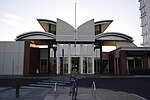Thornbury, Victoria

Thornbury () is an inner-city suburb in Melbourne, Victoria, Australia, 7 km (4.3 mi) north-east of Melbourne's Central Business District, located within the City of Darebin local government area. Thornbury recorded a population of 19,005 at the 2021 census.Thornbury is bordered by the Merri Creek to the west, and the Darebin Creek to the east. The heart of Thornbury is known as Thornbury Village, and is located at the centre of Thornbury, at the intersection of High Street and Normanby Avenue/Clarendon Street. Thornbury is shaped as a thin strip of land sandwiched between Northcote and Preston. Its east–west distance is four times its north–south distance. For 111 years, Thornbury was part of the former City of Northcote local government area, which existed from 1883 until June 1994. As such, Thornbury is universally understood to be a demographic and commercial satellite of Northcote, along with Westgarth, although the latter does not have its own postcode.
Excerpt from the Wikipedia article Thornbury, Victoria (License: CC BY-SA 3.0, Authors, Images).Thornbury, Victoria
Clarendon Street, Melbourne Thornbury
Geographical coordinates (GPS) Address Nearby Places Show on map
Geographical coordinates (GPS)
| Latitude | Longitude |
|---|---|
| N -37.76 ° | E 145.007 ° |
Address
Clarendon Street
Clarendon Street
3071 Melbourne, Thornbury
Victoria, Australia
Open on Google Maps







